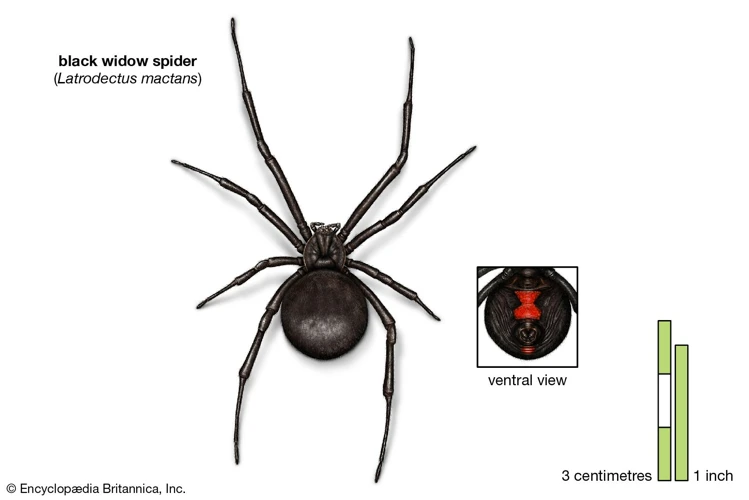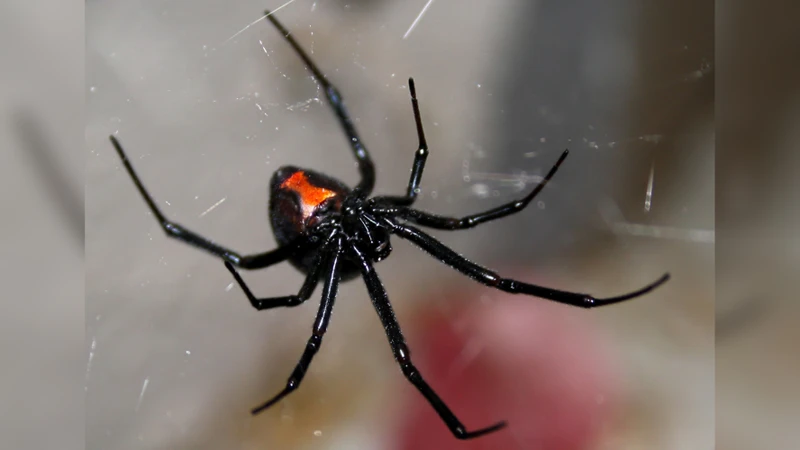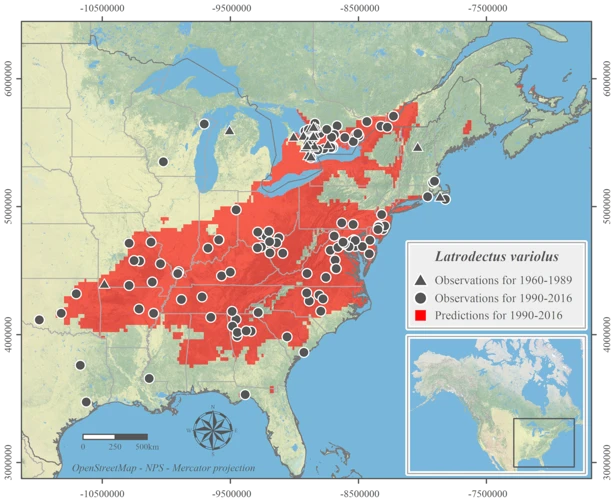As you stroll through the woods, it’s easy to imagine the dangers that could be lurking, hidden amid the underbrush. One such danger comes in the form of the notorious black widow spider. Known for its venomous bite, this spider is feared and simultaneously fascinating. But have you ever wondered about the range of the black widow spider in North America? In this article, we will explore this arachnid’s preferred habitats and geographic distribution as well as the factors that affect its range. So, grab your bug spray and let’s delve into the world of the black widow spider in North America.
Overview of Black Widow Spider Range

It’s fascinating to explore the range of black widow spiders that populate North America. These spiders are renowned for their venomous bite and glossy black appearance, which makes them a topic of curiosity and intrigue. Understanding the range of the black widow spider requires an examination of their geographic distribution, preferred habitats, and factors that affect their range. This article will provide a comprehensive overview of the black widow spider’s range and the factors that impact their distribution, from climate to competitors and predators. To learn more about black widow spiders and their habitats, you can click here for additional information on common nesting sites and their physical features.
Geographic Distribution
Geographic Distribution of Black Widow Spiders
The black widow spider is found in different parts of the world including Africa, Asia, Australia, and North America. In North America, they have a wide distribution, covering both the United States and Canada. However, they tend to be more abundant in the southern United States than in other regions.
Here are some specific locations where black widows spiders can be found:
- Florida: Black widow spiders are commonly found in Florida. The warm and humid climate provides an ideal environment for the spiders to thrive. However, black widows are not the only venomous spider found in the state. Brown recluse spiders also inhabit the region and can be easily confused with black widows.
- California: Black widows are also prevalent in California. In fact, they are one of the most commonly encountered spiders in the state. They can be found in both urban and rural areas, and thrive in the hot and dry climate.
- Texas: Texas is another location where black widows are commonly found. The humid climate provides the ideal breeding conditions for these spiders. Black widows can be found in almost every region of the state, but they are more common in the southern part of the state.
Black widows tend to thrive in dark areas, such as basements, garages, and sheds. They prefer to set up their webs in areas that are not frequently disturbed, which is why they are often found in attics or unused rooms. They also tend to prefer nesting sites that are hidden or concealed.
Factors Affecting Black Widow Spider Distribution
The geographic distribution of black widows is influenced by several factors. One such factor is climate. Black widows tend to thrive in warm and humid conditions, which is why they are more common in certain regions. Food availability is another factor that affects their distribution. Black widows prey on other insects, and their distribution is more prominent in areas that have a high insect population.
Predators and competitors also play a role in the distribution of black widow spiders. They have natural predators, such as birds, lizards, and other spiders, which can limit their distribution in certain areas. Additionally, the presence of other types of spiders can reduce black widow populations, as different species will compete for resources.
Black widow spiders are highly adaptable, and their distribution is influenced by a combination of factors, including climate, food availability, and predators. Understanding these factors can provide insight into why black widows tend to be more abundant in certain areas and help individuals take precautions to avoid negative interactions with them.
Preferred Habitat
The preferred habitat of Black Widow Spiders usually includes warm, dry, and dark areas. They are most commonly found living in outdoor environments such as gardens, trash cans, and woodpiles as these locations provide easy access to their prey, including insects and other small animals. Black Widow Spiders also tend to inhabit human-made structures such as barns, sheds, and basements due to their ability to adapt to these surroundings.
The spiders typically construct webs in secluded locations which they use to catch their prey. The webs are made of a strong and sticky silk that aids in the trapping of insects. Black Widow Spiders are also known to construct their nests near potential food sources to increase their chances of survival.
While they are commonly found in warm regions, Black Widow Spiders have also been spotted in colder areas such as Canada and Alaska. However, they tend to live in indoor environments in these regions to escape the harsh climate. They are more commonly found living in areas with well-drained soil and adequate water sources.
It is important to note that Black Widow Spiders are venomous and a bite from them can be dangerous to humans. It is crucial to take necessary precautions and avoid contact with them whenever possible. In case of a bite, medical attention should be sought immediately to avoid any severe reactions.
The preferred habitat of Black Widow Spiders is warm, dry, and dark areas which provide easy access to prey. Although they can live in various environments, they tend to thrive in outdoor settings.
Where Black Widow Spiders are Found in North America

The Distribution of Black Widow Spiders in North America
Black Widow spiders are found throughout North America, with their distribution influenced by a variety of factors such as climate, food availability, and predators. Understanding where these spiders can be found is important for those living in areas with high populations of black widows, as bites from these venomous spiders can be dangerous. Let’s explore the United States and Canadian ranges of the Black Widow spider in more detail.
United States Range
United States Range: Black widow spiders have a widespread distribution across the United States, from the Pacific to the Atlantic coasts. However, they are more common in the southern regions of the country due to the warm climate, which is favorable for their survival. These spiders are found abundantly in areas such as Florida, Texas, and California, but can also be found in states like New York, Pennsylvania, and Ohio, where they are less common.
Black widow spiders are prevalent in a variety of habitats in the United States, but they are most commonly found in areas with ample hiding places. They typically reside in dark, undisturbed areas such as in sheds, garages, logs, and trash cans. These spiders prefer dark areas because they offer protection from predators such as birds and other animals.
When it comes to biting humans, the western black widow spider is known to be the most venomous species. Due to this, most black widow bites are reported from the western regions of the U.S. In recent years, there have been several cases of black widow bites reported in the southern regions of the U.S., indicating that their range is expanding over time.
Factors such as climate and food availability greatly affect the range of black widow spiders in the United States. The warm climate in southern regions of the country provides a suitable habitat for these spiders to thrive. Additionally, the abundance of food sources, such as insects and other small animals attracts them to these areas.
Black widow spiders have several predators and competitors in the United States, such as birds, reptiles, and larger spiders. They have developed certain physical features and adaptations for survival which include their venomous bite, dark coloration for camouflage, and their ability to reproduce quickly.
While black widow spiders are found throughout the United States, they are more prevalent in the southern regions of the country. They are commonly found in dark hiding places such as sheds, garages, and logs. Their range and distribution are greatly affected by climate and food availability, as well as their predators and competitors.
Canadian Range
Canadian Range:
Black widow spiders are also present in Canadian territory but their range is restricted to southern parts of the country. Although there are no confirmed reports of black widow spider bites in Canada, these spiders have been reported in different provinces including Ontario, Quebec, British Columbia, Manitoba, and Saskatchewan (source). In Canada, black widow spiders are generally found in the warmer areas of the country, particularly in the southern regions where the climate is relatively mild.
To survive in colder temperatures, black widow spiders in Canada prefer to make their nests in protected areas such as homes, sheds, garages, and other undisturbed structures (source). They may also reside in dark and damp areas, which provide them with a suitable microclimate for their survival. In contrast to the United States, black widow spiders in Canada generally reside in human-made structures rather than natural environments.
It is suggested that the climate is the main factor limiting the range of black widow spiders in Canada. Their northern range is restricted by the lack of suitable habitats and the harsh climatic conditions that prevail beyond southern latitudes (source). Factors such as cold temperatures, a short growing season, and the unavailability of adequate prey base pose a significant challenge for their survival. The black widow spider range in Canada is limited due to the adverse effects of climatic factors on their survival.
| Province | Range |
|---|---|
| Ontario | Southwestern Ontario |
| Quebec | Southern Quebec |
| British Columbia | Lower Mainland region |
| Manitoba | Southern Manitoba |
| Saskatchewan | Southern Saskatchewan |
If you want to know more about the factors affecting the distribution of black widow spider, check out our article on this topic.
Factors Affecting Black Widow Spider Range
Understanding the factors that shape the range of black widow spiders is crucial for predicting their distribution and abundance across North America. Though they are commonly associated with dark and secluded areas, there are several other factors that contribute to their survival and persistence in the wild. In this section, we will explore the key factors, including climate, food availability, and competition, affecting the range of black widow spiders in North America. Additionally, we will discuss the ways in which black widow spiders have adapted to these challenges for survival.
Climate
Climate significantly affects the range and distribution of black widow spiders throughout North America. These spiders are more commonly found in warmer areas and can be scarce or absent in colder regions. They prefer temperate climates with moderate humidity levels, especially in regions with temperatures ranging from 70-90°F.
In areas with extreme temperatures such as deserts or high-altitude regions, black widow spiders may have difficulty surviving due to extreme heat or cold. However, they have adapted to survive in a range of environments, including urban areas, where temperatures may be higher due to the urban heat island effect.
Changes in climate patterns and warming temperatures have led to an expansion of the black widow spider’s range; they are now found further north than they were only a few decades ago. This is due to the fact that warmer temperatures provide more time for the spiders to breed and reproduce.
In addition to temperature, precipitation levels also have an impact on black widow spider range. For instance, droughts can cause the spiders to migrate to areas with higher humidity levels, while flooding can destroy their nests and reduce breeding success.
Climate is an essential factor that impacts the distribution and range of black widow spiders in North America. Keep in mind that the spiders have also adapted in ways to survive in various climates and environments.
Food Availability
Black widow spiders are known to be opportunistic predators, meaning that they can feed on various types of prey. However, they do have a preference for certain types of insects. They typically prey on flies, mosquitoes, grasshoppers, beetles, and caterpillars.
Interestingly, black widow spiders have been observed to prey on other spiders including their own kind in cases of food scarcity. One study showed that black widow spiders were able to survive for up to 250 days without food, but they needed water to survive.
When it comes to food availability and the range of black widow spiders in North America, it is important to note that their distribution is somewhat limited by the availability of prey. They are not found in areas where food sources are scarce, and they are more likely to thrive in areas where prey is abundant. This is one of the reasons why they are commonly found in areas with high vegetation and where there is a lot of insect activity.
Black widow spiders are known to weave their webs in or near areas with high insect activity as this greatly increases their chances of catching prey. Some common nesting sites for black widows include under rocks, in woodpiles, in hollow tree trunks, and in abandoned burrows created by other animals.
If you are looking to avoid encounters with black widow spiders, you should be cautious in areas with high vegetation, as well as areas with high insect and spider activity. You can take precautions by wearing protective clothing, checking areas before sitting or placing your hands, and keeping dark areas free of debris and clutter where spiders may prefer to nest. In case of a bite, it’s important to seek medical attention immediately.
Predators and Competitors
Predators and Competitors
Although black widow spiders are infamous for their deadly venom, they have several predators and competitors which affect their range and survival. Some of the main predators of black widows are birds such as the mockingbird, scrub jay, and roadrunner. These birds have developed a resistance to the spider’s venom, making them natural predators.
Another natural predator of black widow spiders is the spider wasp. The wasp captures and paralyzes the spider, lays eggs on it, and leaves it to serve as a live food source for the newly hatched wasp larvae.
In addition to predators, black widows also face competition from other spider species. One such competitor is the brown widow spider, which has a similar appearance to the black widow but with a lighter coloration. Brown widows have been observed to outcompete black widows in some areas.
The presence of predators and competitors can limit the range of black widow spiders. For example, areas with high bird populations may have lower numbers of black widow spiders due to predation. Increased competition from brown widows can prevent black widows from establishing a sustainable population.
It is important to note that despite these challenges, black widow spiders have also developed various features for survival, such as their strong webs and ability to adapt to different environments. Understanding the natural predators and competitors of black widow spiders can provide insights on their behavior and distribution.
Internal link: Predators of Black Widow Spider
Conclusion
In conclusion, Black Widow Spiders have a wide range across North America with different factors affecting their distribution. They prefer warm and dark areas with a steady supply of food and protection from predators. While they have adapted to survive in various climates and situations, their survival is dependent on their ability to find suitable nesting sites and food sources. Despite their reputation as venomous spiders, black widow spider bites are still relatively rare and are commonly found in specific areas of the body, such as the hands and feet. Common nesting sites for black widow spiders include woodpiles, attics, and outdoor structures, so it is important to take caution and protect yourself when in these areas. Overall, black widow spiders are fascinating creatures that have evolved to survive in diverse environments and continue to thrive in their respective habitats.
Frequently Asked Questions
What is the geographic range of black widow spiders?
Black widow spiders are found throughout most of North America, from southern Canada to Mexico.
What habitat do black widow spiders prefer?
Black widow spiders prefer to reside in warm and dry environments, such as woodpiles and rock crevices.
Are black widow spiders found in every state within the United States?
No, black widow spiders are mainly found in the southern and western regions of the United States.
What is the typical size of a black widow spider?
Black widow spiders range in size from 1/2 inch to 1 1/2 inches in length, with females generally larger than males.
What is the venom of a black widow spider like?
The venom of a black widow spider is neurotoxic and can cause severe pain, muscle spasms, and in rare cases, death.
What do black widow spiders eat?
Black widow spiders primarily feed on insects, but will also consume small animals such as lizards and mice.
Do black widow spiders have any natural predators?
Yes, black widow spiders have several natural predators including birds, reptiles, and other spiders.
How does climate affect the range of black widow spiders?
Climates that are too cold or moist will limit the range of black widow spiders, while warm and dry climates will expand their range.
Are black widow spiders dangerous to humans?
Yes, black widow spiders are considered dangerous to humans due to their venomous bite.
What should I do if I am bitten by a black widow spider?
If you are bitten by a black widow spider, seek medical attention immediately as the venom can cause serious health problems.






